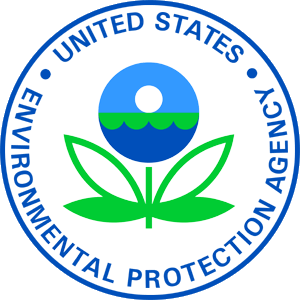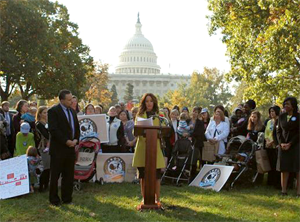Now that the final Toxic Substances Control Act (TSCA) reform bill is on the President’s desk, it is a good time to reflect on what it represents and what’s next. We’ve posted a fact sheet on the final bill here if you want an abbreviated, but relatively thorough, rundown of the issues.
 First, I want to thank all of our supporters for their hard work. The moms and dads and doctors and nurses that participated in our Stroller Brigades locally and in DC should appreciate the impact that you’ve had. Also, I want to thank our many coalition partners, national and local, who mobilized varied expertise and diverse memberships. Together we were able to turn this legislation around in three years to something that is at least net positive for public health and the environment. The combination of grassroots activism and constructive engagement on the policy questions worked. It did not work well enough for us to endorse, but the bill should do more good than harm. Pat yourself on the back. This is not a champagne moment, but you deserve a beer at least.
First, I want to thank all of our supporters for their hard work. The moms and dads and doctors and nurses that participated in our Stroller Brigades locally and in DC should appreciate the impact that you’ve had. Also, I want to thank our many coalition partners, national and local, who mobilized varied expertise and diverse memberships. Together we were able to turn this legislation around in three years to something that is at least net positive for public health and the environment. The combination of grassroots activism and constructive engagement on the policy questions worked. It did not work well enough for us to endorse, but the bill should do more good than harm. Pat yourself on the back. This is not a champagne moment, but you deserve a beer at least.
Here are the takeaways I would suggest for key constituencies:
To the concerned public: Keep up your guard and stay involved.
You know who you are. You might not be a professional advocate, but you have become a change-maker for a safer environment for you and your family. You choose safer products, but also take action, at least occasionally, to push for more systemic improvement. You might come at the issues from the perspective of breast cancer, from a concern about learning disabilities, or just general concern for public health. The key question you have is: does this bill solve the problem of toxic chemicals? The short answer is no. No one can credibly argue that this bill solves the problem of toxic chemicals and their impact on public health in the United States. The progress at the federal level will just be too slow.
The good news is that because of the reforms, the federal government can finally be part of the solution. The EPA can get in on the action of advancing public health and environmental protection. Consumer-driven campaigns will probably still produce more change, more quickly than EPA can. So keep reading labels and keep taking action for your own family and the broader world. Keep pressuring companies to substitute safer chemicals for unsafe ones. Keep holding your retailers accountable for what they sell through our Mind the Store campaign and similar efforts. But now, also help us keep EPA’s feet to the fire to use their new powers to the maximum degree.
To my coalition partners and allies: Let’s use this new law.
This is not the reform we set out for by a long shot. I am acutely aware of that, perhaps more than anyone. The chemical industry’s power in the political process was too great and reflects a normalization of the corrupting influence of big money. Some key allies, inside and outside of government, let us down at critical moments. It was enormously frustrating.
And yet… we won on several important issues. The key legal roadblocks that have prevented EPA from taking action on chemicals have mostly been removed. The provision requiring identification and protection for disproportionately exposed populations provides a powerful new handle for environmental justice communities and workers like fire fighters. The requirement to identify and protect populations that are disproportionately susceptible to injury provides a potentially powerful handle to protect the developing fetus and child from endocrine disrupting chemicals. The mandatory schedule and deadlines in the bill are lame, sure, but even a relatively small number of chemicals can impact millions and millions of people. If EPA gets it right, and truly implements the letter and spirit of these provisions, we could prevent new harm from those chemicals and have a positive impact on a substantial part of the population. The provisions on chemical testing and confidential business information also provide opportunities to advance public health. Let’s bring our A-Game to implementation and get the most out of what we won. Let’s also continue to watchdog the issues like low priority and import notification that pose risks.
Europe will still be the leading edge of global regulation. States will still be the leading force domestically. Market campaigns will produce change more quickly especially for particular chemical and product combinations. We must keep firing on those cylinders, but we now also have the potential for significant gains from EPA.
To State Legislatures, Governors, and Attorneys General: You’re still the Watchers on the Wall.
Yes, that’s a Game of Thrones reference and yes, I’m a nerd. (Don’t kid yourselves, you’re nerds too.) In the show, the Night’s Watch is an underfunded and understaffed cadre of public employees guarding an aging infrastructure (the Wall) against an ancient evil that threatens the “realms of men.” Sound familiar? The fact is that you still have a critical job to do. In the parlance of the show: Your watch has not ended.
As you know, state authority was probably the most contentious issue in this debate. The coalition fought hard to protect it. I’m sorry that we could not do better. The early or “pause” preemption in the bill is a ridiculous idea that became the proverbial “pound of flesh” that the American Chemistry Council demanded in this debate. The waiver for states is pretty convoluted too. The fact that the final bill included these is particularly difficult to swallow since we had a House bill that avoided them entirely.
But there is a flip side: TSCA is now reformed and no one, no one, can credibly argue that it takes the place of state chemical regulatory activity. ACC will be peddling that line in state capitols but we both know that they are completely full of crap. The pace of chemical reviews will simply be too slow to make that claim stick.
And because the preemption in the bill is tied to the progress that EPA makes chemical-by-chemical, that means state authority is preserved in full for the vast majority of chemicals. Also, take special note of the inclusions and exclusions from preemption even when EPA does take action. The grace period of 12 to 18 months for states to act on a chemical that EPA has prioritized is important too. States are not encumbered by the burdens of proof and analysis that will still weigh the federal program down, so state action, even on a chemical EPA has just prioritized, will often make sense and it will be still be possible under the bill. It’s worth noting that TSCA doesn’t apply to certain categories of chemical use, such as food packaging and cosmetics, so states are free to take the lead there too.
TSCA reform is finally here and it falls demonstrably short of what’s needed to fully protect public health and the environment. Your service at the state level – on the Wall – is still critical. That sound you’re hearing is not the buzzer, but the opening bell.
To Retailers: Customers won’t wait for EPA.
You’re in business and you know that the customer is always right. Many of you have responded to consumer demand for safer products by enacting your own policies to exclude certain chemicals of concern from what you sell or to require disclosure. Many more of you are contemplating new policies. Some of you have turned to EPA’s voluntary Safer Choice program for guidance in identifying safer substitutes. The chemical industry will surely insist that a reformed TSCA means EPA is now “on it” and you can now stand down. But you’re smart enough to know that you don’t want to tell a mom that you don’t care about the chemical in something she bought from you because EPA might look at that chemical five years from now.
So you’re still on the hook to be a part of solving this problem. The efforts you have made to promote safer substitution and innovation have already made a big difference. Products are safer today than three years ago because of retailer-driven change. So rather than slowing down, you could speed up. There may even be tools in the reformed law that could help you in terms of requiring information to be developed or declassified about a particular chemical. We will continue to be your partners, and nudge you when necessary.
To EPA: Let’s have a strong start.

Congratulations! You now have new authority. Are you ready to use it? The slower schedule in the final legislation was in many ways a response to your demand that the program not “set the agency up to fail.” So if the pace will be slow, it’s on you to ensure the maximum public health improvements are extracted from this process. We encourage you to take the protection of disproportionately exposed and susceptible populations to heart and ensure your evaluations and restrictions reflect the realities of toxic chemical exposure in this country. Also to use the best available science, like aggregate and cumulative exposure analysis, recommended by the National Academies of Sciences. The provisions on Work Plan chemicals and PBTs allow you to take expedited action on some of the worst chemicals. Use them.
We also encourage you to think expansively about some of these powers like testing authority. There is a broader demand for credible toxicity information about chemicals from various players in the marketplace who are looking to make the right decisions about the chemicals they choose to use in their products. Engage with them and don’t only require testing for the chemicals that you are planning to review in the near term.
The more you use the new powers effectively, the more of a constituency the program will have. The chemical industry will push back, of course, but the broader public health community, environmental groups, mom bloggers and others are rooting for you. We stand ready to help secure adequate funding and we plan to participate in the process.
With the reformed law, you can now join the states on the Wall guarding against unsafe chemicals. Your watch has begun.




